ALREADY A PAID SUBSCRIBER? SIGN IN
ALREADY A PAID SUBSCRIBER? SIGN IN
ALREADY A PAID SUBSCRIBER? SIGN IN
ALREADY A PAID SUBSCRIBER? SIGN IN
This week we have reached the tipping point. The seasonal fulcrum when winter begins the ascent to spring. As the days lengthen we note with excitement the increasing light. ‘4 o’clock! 5 o’clock! 5.30!’.
And with the light and milder days come the flowers. Some are naturally early, like the snowdrops which pass the baton in a relay race from pre-Christmas to their peak in mid-February and the brave early hellebores which sacrifice themselves to the hail and cold driving rain of January. Others, like the Iris reticulata and a few choice narcissus, have been brought on in the cold frames to be brought to the table outside where they prophesy the change of season a few cheating weeks in advance. Pots of hope and anticipation.
But now the first emergents are gathering pace. Winter aconite and witch hazel, pussy willow and violets, cardamine and primrose, wintersweet and cornelian cherry. Diminutive and delicate by and large, but strong and sturdy enough to brave the wintery showers, these torchbearers of the coming wave are always welcome.
Last year the photographer, Eva Nemeth, visited us in every season to photograph the garden for House & Garden magazine. On each visit she also created a speciality of hers, a beautifully composed flat lay of flowers picked from the garden. Earlier this week she posted an image of the one she photographed exactly a year ago on Instagram and we were surprised to see that many of the flowers that were blooming at the beginning of February last year were not yet showing themselves. It prompted me to collect as many of the early showers yesterday to make a comparison.
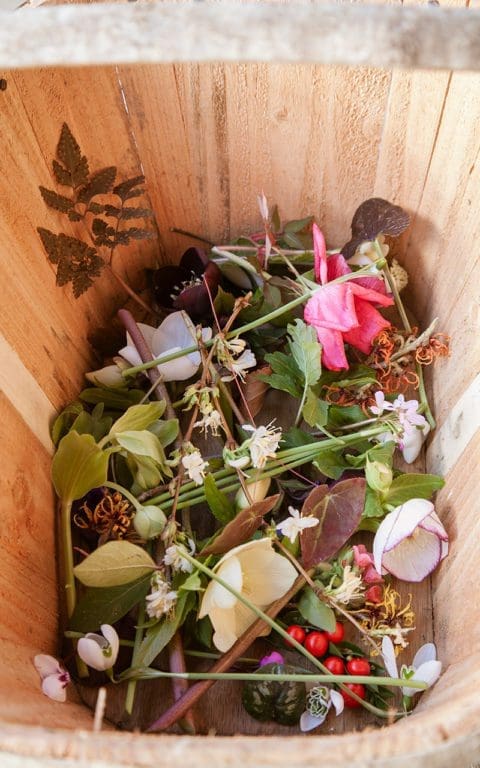
As you can see there is plenty in the garden to encourage us out, despite the cold. The majority of them are small and delicate and so must be sought out, which is all part of the pleasure, of course. Picking and recording them like this, however, really makes you appreciate the amount of flower even these early risers provide for early foraging bees which, on warm days can already be found thrumming on the snowdrops, hellebores and pulmonaria.
Also this week the findings of a scientific study published by The Royal Society indicate that the flowering times of a wide range of native species has advanced by more than a month (mid-May to mid-April) since the late eighteenth century and has accelerated noticeably in the last thirty years, due to climate warming. Although the early flowers we are seeing today bring cheer and a sense of hope the majority of these plants are still flowering at the times that we are used to. However, the issue of advancing flowering times later in the season is very serious. The two main issues are exposure to frost for species that are not frost hardy, in particular food crops such as fruiting trees, and ‘ecological mismatch’, which occurs when certain species flower out of sync with the insects and vertebrates that are reliant on them for part of their life cycle.
Although the study has not looked at the flowering times of non-native garden plants, one hopes that by planting a wider variety of ornamental garden plants that are closely related to or fill a comparable ecological niche to some of our natives (as shown in the findings of the University of Sheffield’s Biodiversity in Urban Gardens Project (BUGS) and the RHS Plants for Bugs research) will go some way to helping mitigate these issues.
Words & photographs | Huw Morgan
Published 5 February 2022
The first of the early season snowdrops are already brightening these darkened days and the season is made that much lighter for their companionship. A winter without them would be a very different thing and I freely admit to being thrown under their spell. A charm that was cast a few years ago with a handful of treasures that were kindly gifted to me by Mary Keen at one of her snowdrop lunches. Snowdrops that she took us to meet in her wintery garden and plants she had taken her time to get to know and were different enough from the usual Galanthus. Plants that gently entice you from the standing position to slow and ponder their particular qualities. A nod that distinguishes them from the crowd, a green tip to the outer petal perhaps, a puckering like seersucker or a completely albino or even gold interior.
I have never been a collector for the sake of collecting and I know from friends who have also found themselves spellbound, that galanthophilia is a slippery slope that can easily lead to a world of obsession and acquisition. That said, and knowing that I wanted to get to know more than a couple of hands full, I struck a pact with myself. To only grow good garden plants. Those which ‘do’ and not those that are fussy and fail on me. I want to be able to see the character of a plant from several paces when it is established and doing what it does best and for each one to offer something distinct. I also want to extend the season forward from February, the main snowdrop season, and to have the company of snowdrops in every week of the winter. Just as I do not want to have hundreds of friends – and bearing in mind that there are 900 or so varieties of galanthus – I just want the ones I can build a relationship with and rely upon. I want the keepers.
It takes time to get to know a plant, so over time I will share with you what I have learned with forms and varieties that are still new to me. The autumn flowering Galanthus reginae-olgae which I have only known for the last three years for instance, which prefer a sunnier, free draining position. It takes three years or so for a single bulb to start to clump and really five before you can see its specific character. How it does in a garden and feels as an individual. A plant such as ‘Fly Fishing’ (kindly gifted, thank you, by our friend Marcia) needs air around it to allow its suspended flowers to dance on elongated pedicels. Timing is also all important, so pairing a variety to coincide with a winter-flowering companion gives a red hamamelis or dark hellebore a bright undercurrent whilst having its moment.
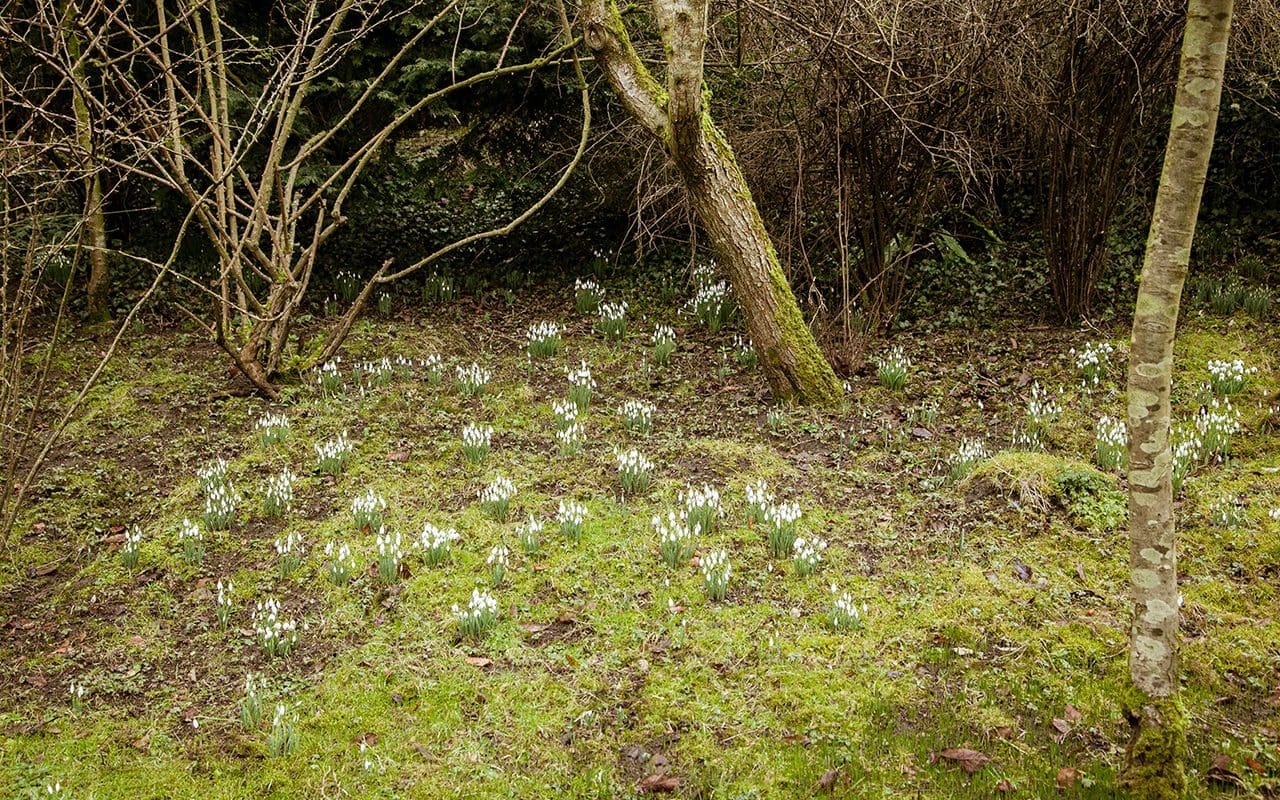
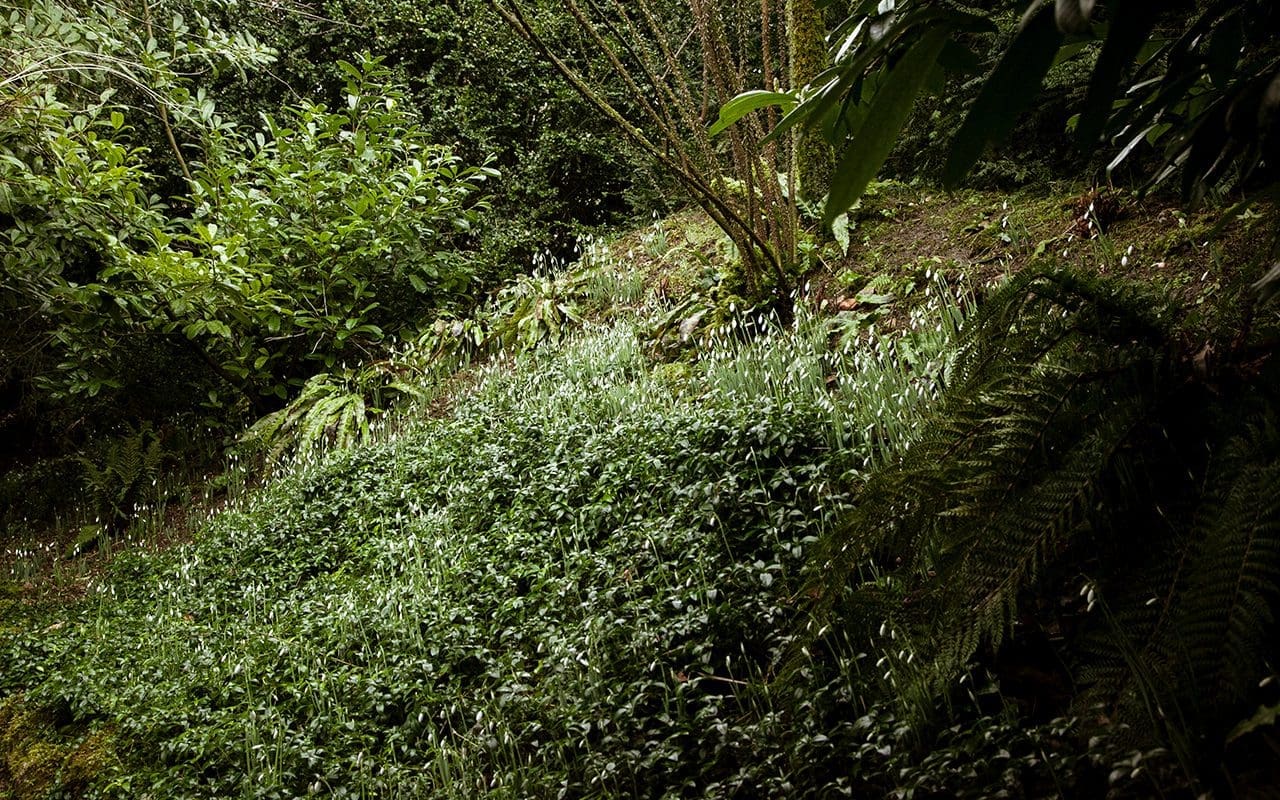
Galanthus are the same as any garden plant. You get a better result for knowing their requirements and how that can be played to best effect in company. As a rule, galanthus like good living and a retentive ground that drains freely and does not lie wet. I planted part of my snowdrop trail in the heavy wet soil at the bottom of the hill where the ground never dries out in summer. The bulbs there failed in the wet areas where the juncus thrived, but the very same soil at the base of trees yielded entirely different results where the trees used the moisture in the summer to give the dormant galanthus a rest. On heavy ground slopes are ideal and hedge banks often provide an ideal position. Lighter soils that are free-draining will benefit from the addition of humus.
Getting to know my collection of ‘specials’ is a learning curve that I am happy to take my time to understand. I buy one bulb of each variety, ideally at the beginning of the growing season so that I can see them complete a life cycle. Paul Barney at Edulis Nursery has a distractingly good collection. I grow them in a stock bed at the base of a hawthorn hedge where in summer they can retreat into safe dormancy. Once they have started bulking, in the third year or so, the clumps are lifted as soon as they have flowered and moved to where I want them to be in the garden. Somewhere close to a path so that I can get to them easily and planted in good company so that they are not overwhelmed too early by precocious pulmonarias or cow parsley.
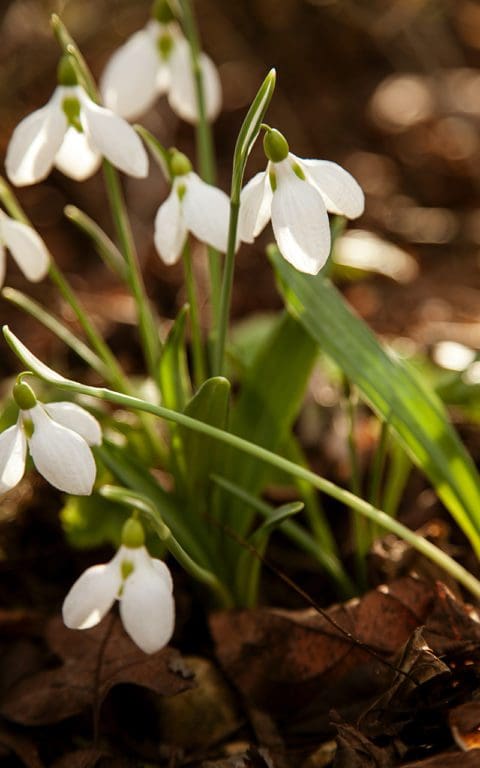
Of the three plants I am sharing with you this early into my chapter of snowdrop distraction, Galanthus plicatus ‘Three Ships’ (main image) is the first to flower after the relay of autumn snowdrops. ‘Three Ships’ was found under an ancient cork oak by John Morley in Suffolk and is reliably in flower at Christmas. Rare for G. plicatus to flower this early, it sits low to the ground over broad widely-spreading foliage, the rounded petals puckered and distinctly textured to capture dew or low, raking light.
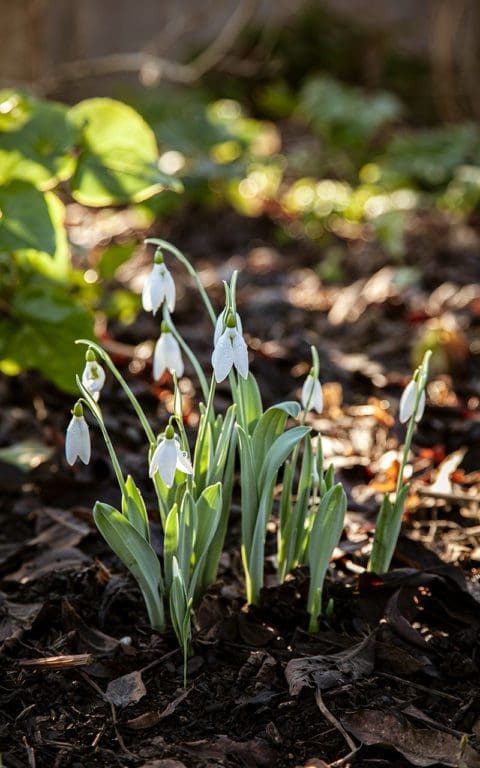
Galanthus elwesii ‘Maidwell L’ was kindly gifted by Simon Bagnall, head gardener at Worcester College, Oxford, once again with the generosity of one galanthus lover to another (thank you). This is an early flowering form of G. elwesii, the broad-leaved species that has spawned a number of early to rise varieties. This is a good one, welcoming the first of January this year and showing vigour and willingness to do well on our heavy ground. I have loved this plant for the graceful unfurling of grey-green foliage, leaves which are broad and unroll like a scroll. A selection from Maidwell Hall, Northamptonshire made by Oliver Wyatt, the flowers stand tall at about 22cm and hold good poise.
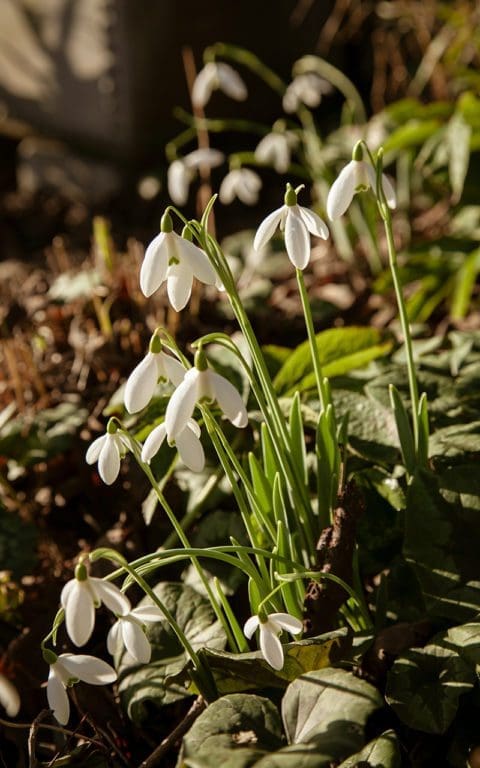
Nearby, under the medlar I have a group of Galanthus elwesii ‘Mrs Macnamara’ (thank you Mary). Named after Dylan Thomas’s mother-in-law who grew it in her garden, it is reliably early and well known for good behaviour. Again, in flower by the first of the month or sometimes a little earlier, this is a nicely proportioned plant that you can recognise from a distance. Narrow, glaucous foliage is not as much part of the mood as it is with ‘Maidwell L’, but it all sits together very pleasingly, the large, slender flowers held perfectly, each in their own space like a drawing of a perfect snowdrop, but with perhaps a little more of everything.
Snowdrops should be split every five or six years to retain vigour in the clumps. I like to plant a couple of bulbs together or three for company as some sit and sulk and are slow to increase if planted alone. Do not ask me why and this is not the case for everybody. Divisions are best made after flowering or as the leaves fade into dormancy and before your attention is drawn elsewhere in spring and the spell they have cast over the winter is broken. As you lift and divide and extend the reach of the plant in question you are left with nothing but good feeling, as you pat the soil and say a little prayer that you will see them again after the commotion of a growing season is spent and done and quietened to allow them their glory.
Words: Dan Pearson | Photographs: Huw Morgan
Published 15 January 2022
Against the odds, the delicate Crocus tommasinianus ‘Albus’ spear the turf on the bank in front of the house. When you first become aware of their presence earlier in the month it is easy to mistake their pale tapers for the light reflecting off blades of grass, but suddenly and all at once they are free. Standing tall enough above the sward to shiver in the slightest of breezes and opening wide in a sunny interlude to reveal orange stamens, yellowed throats and nectar for the early bees.
I first grew Crocus tommasinianus in the Peckham garden and learned to love it there for being the superior cousin to the ‘Dutch’ Crocus vernus which stud front lawns in spring like spilled tins of Quality Street. I did not know it then, but I had been supplied with the true species, which has the palest silvery-lilac reverse to the petals with the colour held within. I have since repeated my orders, again and again and from different places, only to find I have planted a thousand ‘Ruby Giant’ here or two thousand ‘Whitewell Purple’ there. These darker selections are often mis-supplied and sit less lightly for their weight of saturated colour.
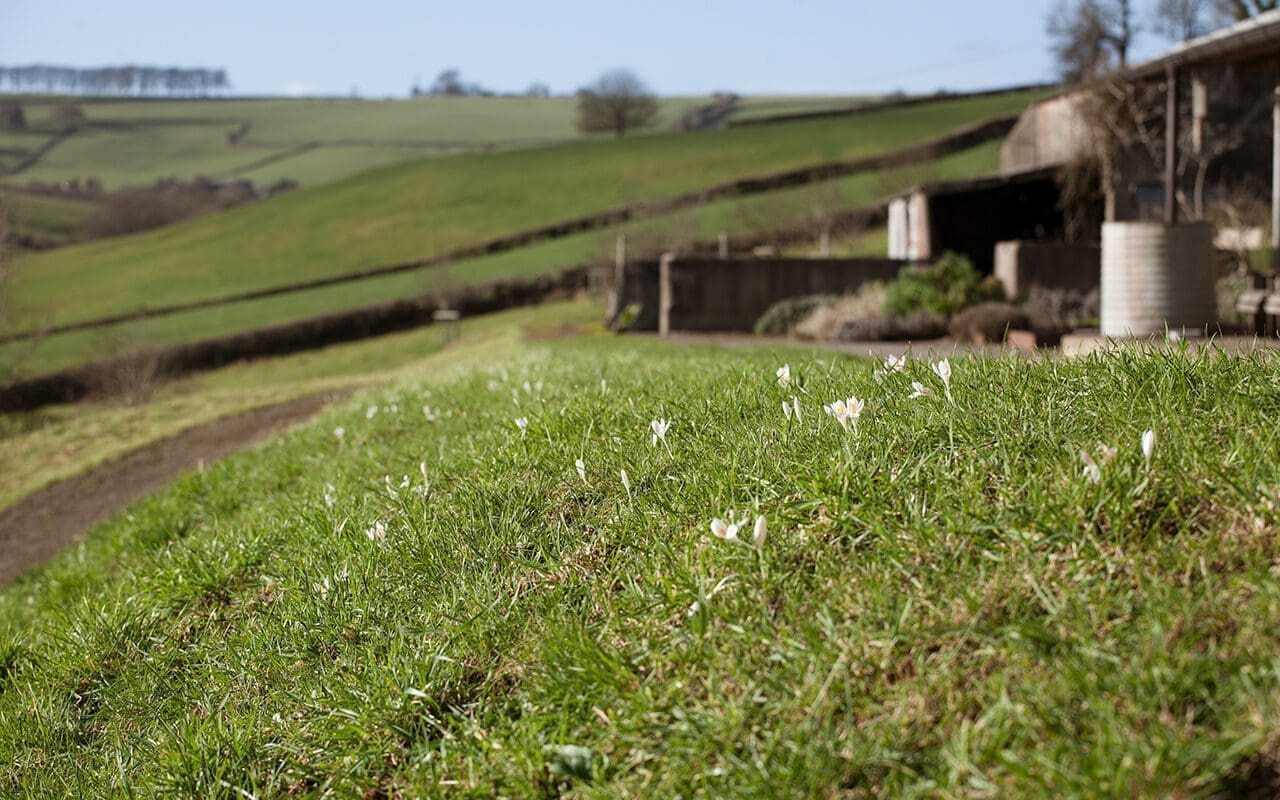
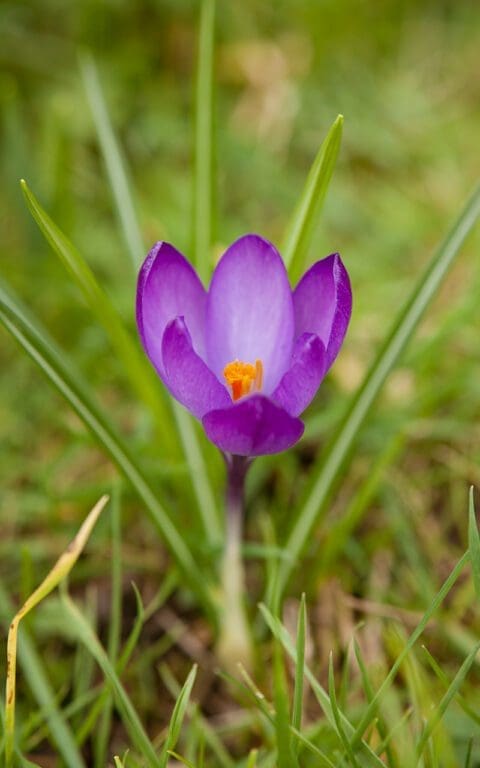
Just up the lane and making the point that they are happy there, the true form has taken over our neighbours’ garden. The sisters that live there are natural gardeners and have been tending theirs now for decades. Without competition the crocus have seeded freely, to the point of flooding the open ground of their borders, seeding into the crowns of all the plants and seizing every niche between paving stones. The garden is free and joyous and Josie and Rachel never see their occupancy as a problem.
We have struck up a friendship and Rachel has generously allowed me to dig them in-the-green immediately after flowering so that I do not have to depend upon the vagaries of the bulb suppliers. I am going to keep them out of the beds here, however, as I want to work in the garden just as they come into leaf when I’m preparing the garden for spring. The sunny banks at the back of the house are where I am hoping they will naturalise. The free-draining slope there is ideal, because they like dry ground when they are dormant and the sunshine ensures that their flowers, which are light sensitive, open to reveal their interiors. When they do, you feel your heart lift and the long dark winter retreat.
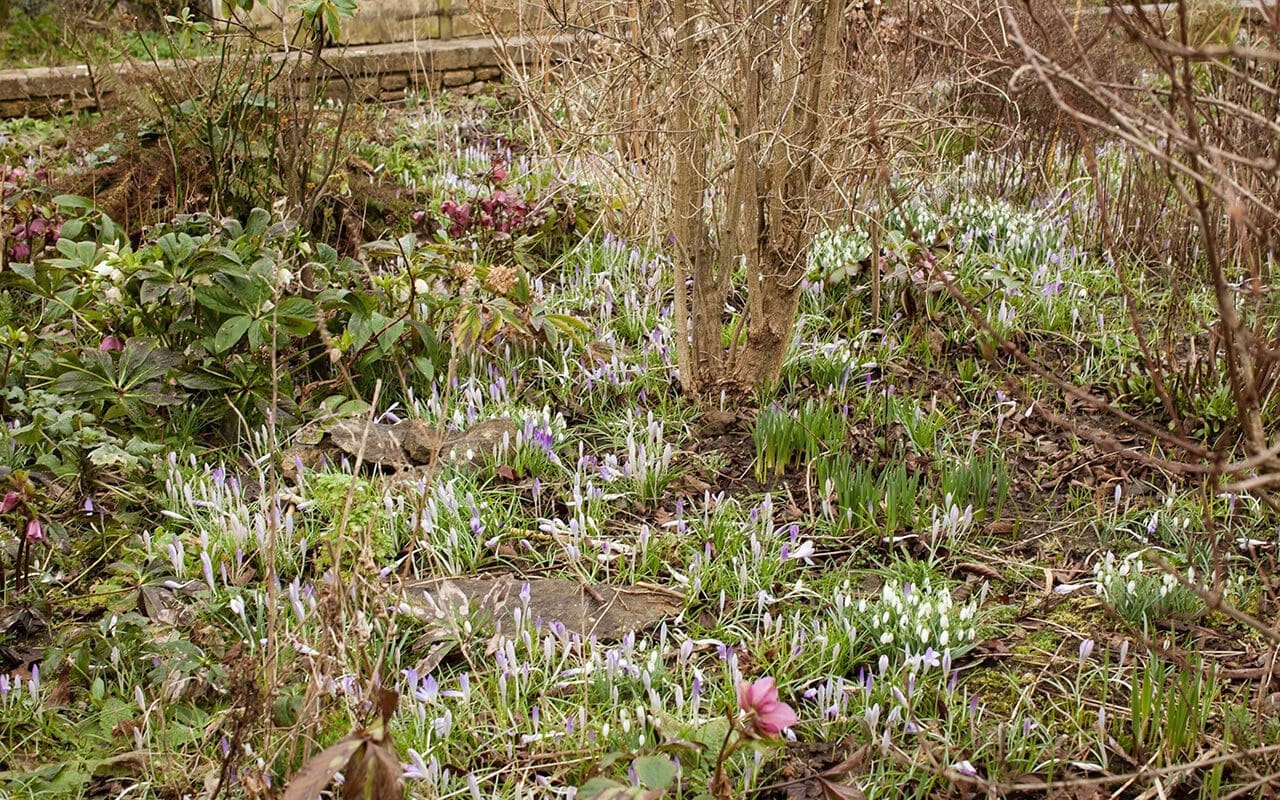
I can already see from their behaviour in the grass under the young crab apples that they will not seed as freely as they have in the open ground of Josie and Rachel’s garden. Though happy in grass, the lushness of our meadows is probably too much for the young seedlings to take a hold. I hope in time, and once the grass thins as the crab apples assert themselves, that they will take to a lighter sward and begin to make the place their own. This is worth waiting for and every year I am adding a few more with Narcissus jonquilla and Anemone blanda to follow after their early blaze is over.
Shipton Bulbs stock a number of special selections that are subtler than the named varieties above. The rosy Crocus tommasinianus ‘Roseus’ (main image) and C. t. ‘Pictus’ which looks as though the tips of the petals have been dipped in ink. The white form, Crocus tommasinianus ‘Albus’, is very choice and, as they do not come as cheap, I ordered a couple of handfuls and gave them their own place on on the bank at the front of the house in the hope that they will not cross with the others at the back. The position here is exposed to our winds that whip across the open ground, but they stand bravely and mark the shift in the season with the snowdrops and the promise of what lies just around the corner.
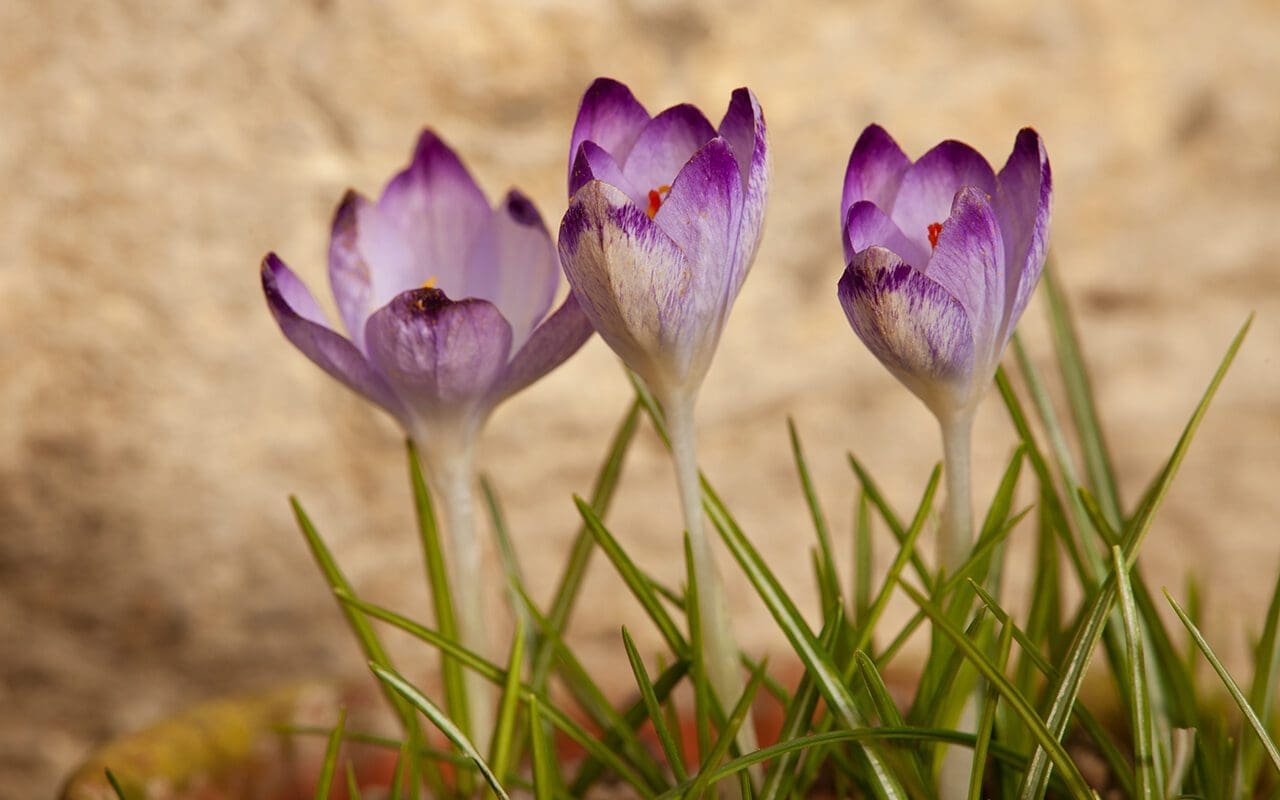
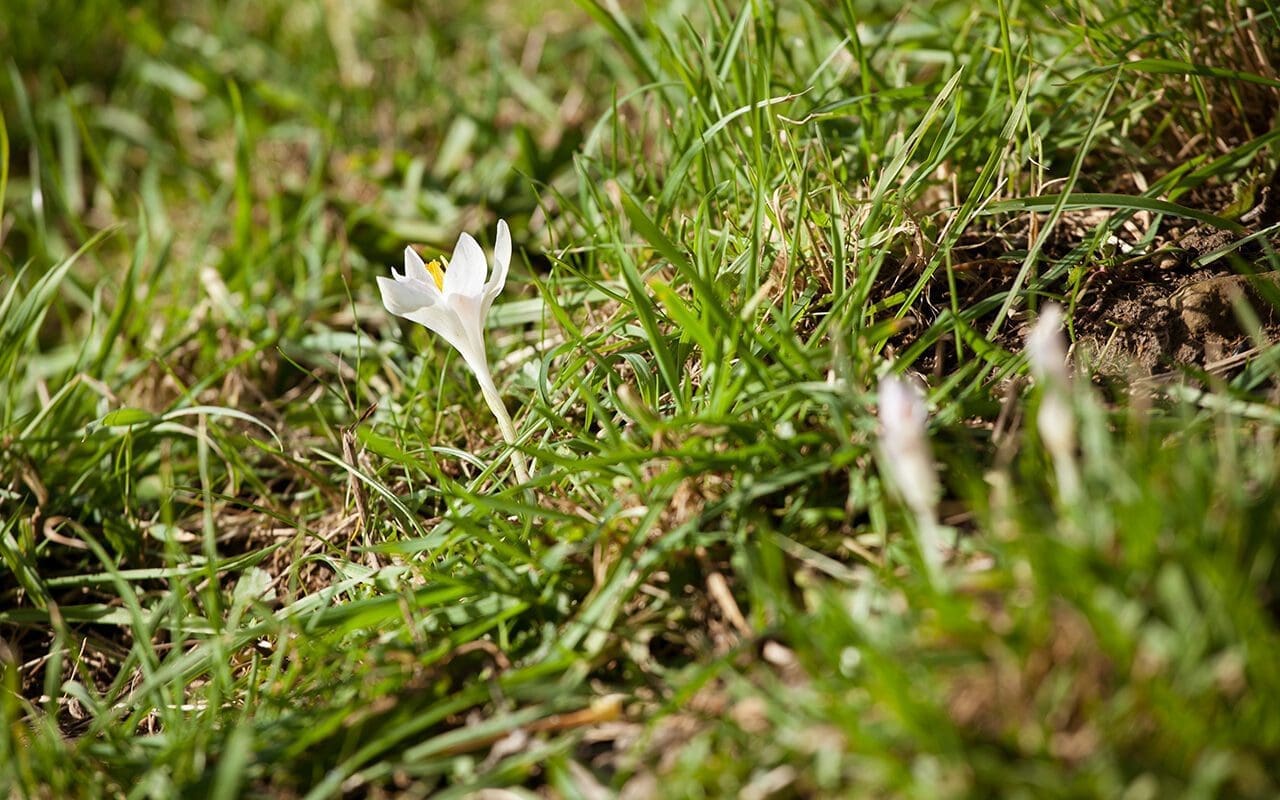
Words: Dan Pearson | Photographs: Huw Morgan
Published 20 February 2021
Last week we passed the half way point between the winter solstice and the spring equinox; the Gaelic celebration of Imbolc. Here in the garden there is a notable shift from slumber. Bright rosettes amongst the leaf litter, looking determined and suddenly visible. Newly green amongst the darkness of foliage from last year, which is daily being pulled to earth by the earthworms and mouldering. The cycle making way and the old providing for the new as the nights become shorter.
In the garden, it was the witch hazel which were the first to stir. I grew them in pots when we were living in Peckham and were pushed for space and needy for more. They were brought up close to the house where their winter filaments could be given close and regular examination. They grew surprisingly well considering their confinement, to the point of outgrowing their summer holding ground in the shadows at the end. I passed them on as they outgrew us. ‘Jelena’ was big enough to warrant the hire of a white van and driver to take it to Nigel Slater in his north London garden. A number went to clients and the remainder came with us in an ark of the best plants to live with us here.
Our sunny hillside with its desiccating breeze does not provide the ideal conditions for hamamelis. In an ideal world they would go down in the hollows, where the air is still and the cool shadows finger from the wood on the other side of the stream. Although they are modest and do bear a likeness to hazel in summer, their winter value is bright and otherworldly. Too bright and too ornamental to sit in the company of natives.
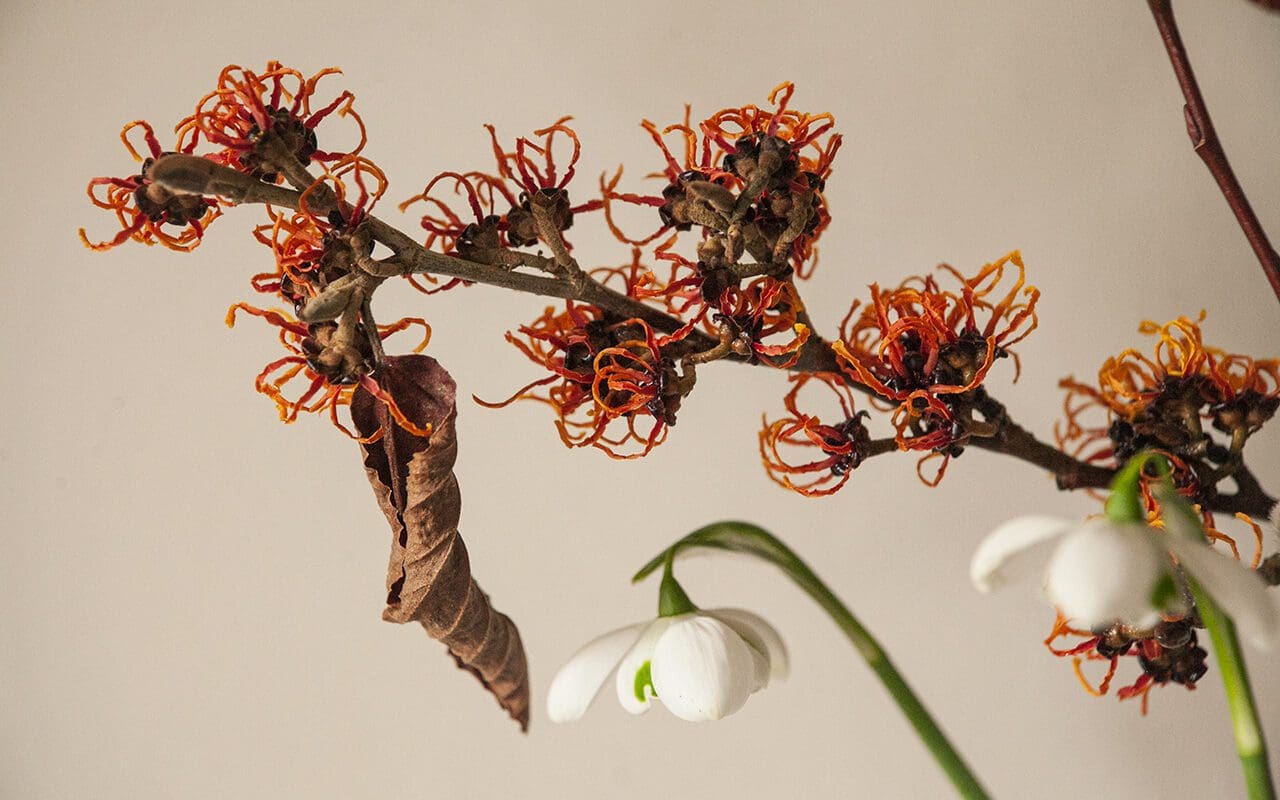
As a highlight of these dark months, the witch hazels are worthy of the pockets of shelter up in the garden. Hamamelis x intermedia ‘Gingerbread’ claims one such position alongside the old milking barn, where the west-facing aspect protects it from the sun for more than half the day when it is at its height. On a still day a delicious, zesty perfume describes a definable place that you encounter as you move alongside the barn. It makes your mouth water. The colour of ‘Gingerbread’ is well named. It is hot and spicy, but dims after a couple of days perfuming the mantlepiece.
The plant must be about fifteen years old, given its time in London and the early years here still confined to its pot. Though slow to settle in, the limbs now reach out widely and provide me with a little microclimate. Its branches offering a shadowy place beneath for lime green hellebores and paris and a climbing frame for scarlet Tropaeolum speciosum, which covers for the witch hazel’s modesty come the summer.
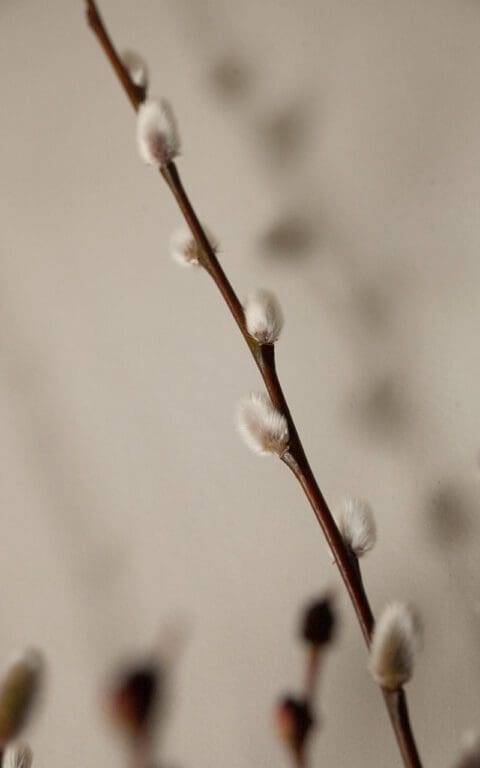
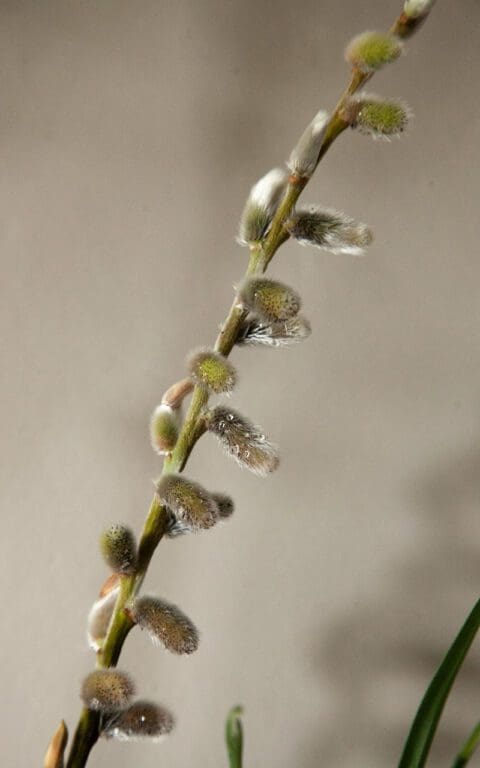
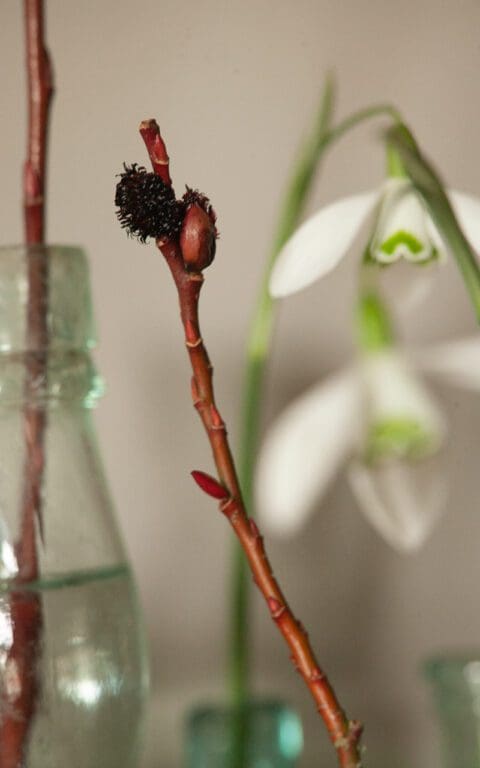
The willows come once the witch hazel are already in bloom, their neatly fitting sheaths thrown aside as the pussies begin to swell. Salix daphnoides ‘Aglaia’ with dark mahogany stems and silver-white catkins sits a walk away as an eyecatcher down in the ditch. Closer in Salix gracilistyla, acts as guardian to either side of the lower garden gate. Not so commonly available as the black form, S. gracilistyla ‘Melanostachys’, or the pink-pussied S. g. ‘Mount Aso’, I love the straight species for the delicacy of silvery-grey. Like the fur of a rabbit, it is impossible not to touch as you move to and fro and I have let the branches reach in from either side to encourage this interaction. As the flowers go over, the bushes will be hard pruned to a framework in early April to keep the plants within bounds so you can see over them and still have the view.
Just a week after the winter mid-way we find ourselves at peak snowdrop. Those in the warmest positions where they bask in winter sunshine have been out already for a fortnight, but right now is the week of the majority, at their most pristine and poised. What the Japanese call shun, the moment when a plant or crop is full of its vital and optimum energy.
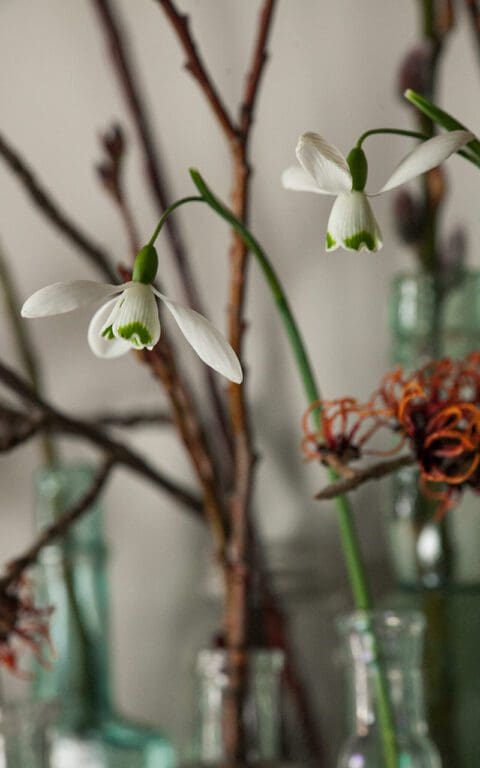
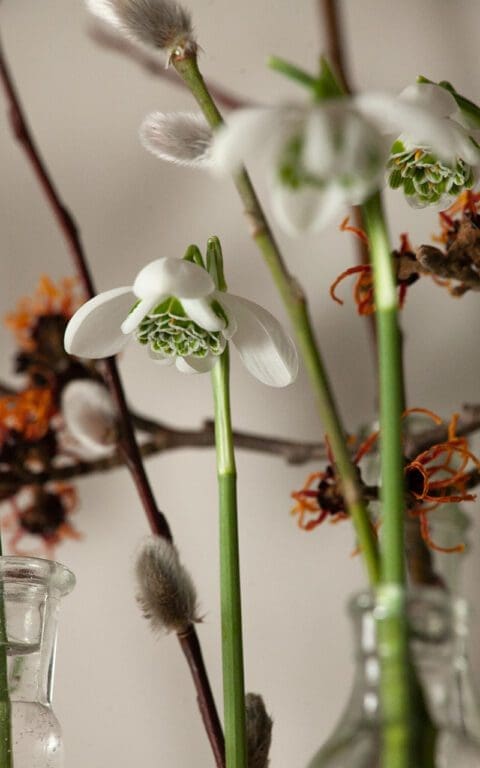
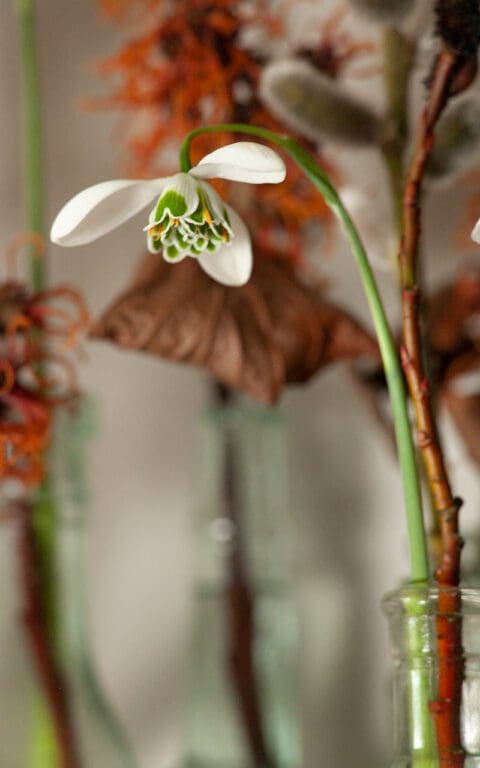
I have fallen under the spell, for the snowdrop’s solitary presence is a tonic when you are pining for life. Their ability to draw you out into the winter and make it a place that is finer for their presence is why, perhaps, when you do find yourself spellbound, you begin to want for more. That is another story altogether. One which I will share with you another year when I feel I know more, but suffice to say I have begun a collection of specials. All three here (each named after characters from Greek mythology) are readily available for being reliably good plants and you can buy them easily enough in-the-green, as bare root bulbs from Beth Chatto’s for planting out now. ‘Galatea’ was first given to me by our friend Tania. The ‘goddess of calm seas’ is a fine reference, but the long pedicel suspends the flower in the arc of a fishing rod, so if there is a breeze, they are wonderfully mobile. In the warmth or on a bright day, they fling their petals back in a joyous movement to expose their skirts to the bees.
Though the doubles tend to last longer in flower, they are not always my favourites. The bees favour them less because they are harder to pollinate and the simplicity of the flower can often be lost in frilled petticoats. Not these two, which both have an interior that is beautifully tailored. ‘Hippolyta’, daughter of the Queen of the Amazons, is the shorter and more upright of the two with a fullness and roundness to the flower which is distinctive from a distance. ‘Dionysus’ has both poise and height, though it is good to plant the doubles on a slope so that you can admire their undergarments. Named after the god of wine (and ritual madness) I am happy to be swept along in a little obsession and midwinter mania.
Words: Dan Pearson | Flowers & Photographs: Huw Morgan
Published 6 February 2021
The Iris unguicularis arrive at precisely the moment it becomes apparent that winter is here to stay. Spearing clear of their strappy foliage whilst the world around them is in retreat, the tightly rolled buds provide untold good feeling. Their intermittence is welcome, the flowers appearing in the mild weeks and not in the cold ones from now until February snowdrops.
Although I have never seen the Algerian iris growing in the wild, I hanker to do so. To follow them one day on a journey through Greece, on into Turkey and all the way through to Tunisia. It would be good to see exactly where they grow in these rocky landscapes and why the best advice in this country is to plant them at the base of a south-facing wall with their backs against the reflected heat and their foliage basking in sunshine. This was exactly how my great friend Geraldine grew them, close to but not in the shade of a twisted fig and with nerines that shared their need for a baking. This was a treasured spot in her garden and I remember her justifying their neglect as she pulled me up a piece one autumn, conjuring, as she did so, their homelands and intolerance of cosseting. No food, no water and certainly no shadow. They prefer, she said, to be growing in rubble.
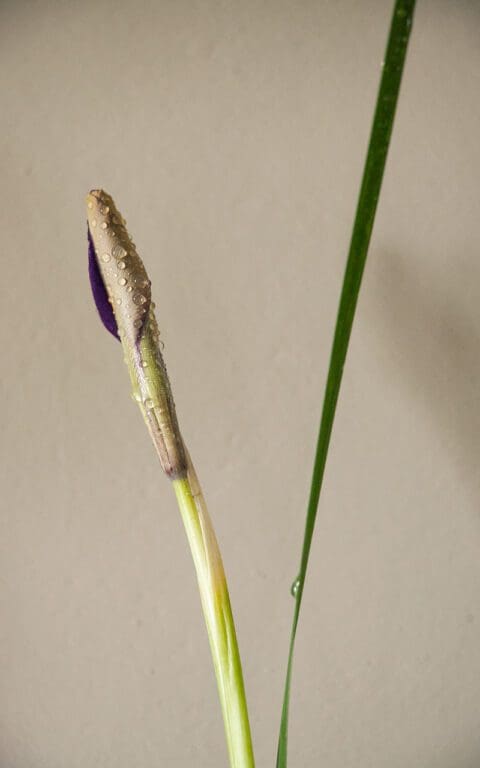
Although I have long since lost the original plant she gave me when I was a teenager, I can see them like yesterday on her kitchen table. Plucked in bud, to get the benefit of a long stalk and savoured expectation, they sat on their own in December and then, as the winter deepened, with witch hazel, pussy willow and wintersweet. The pale buds, with their picotee edging and tease of the sumptuous interiors, unroll in a matter of minutes once brought inside into the warmth. If you are lucky, you will witness the unfurling, but unless you make the time the transformation happens when you have your back turned.
Up close and inside in the warmth, their delicate perfume makes you wonder why they are happy to live with our wet and grey, scowling winters. In the wild, of course, where wet days are reliably followed by a week of bright sunshine, they are forage for bees when little else is blooming.

The plants I have here in Somerset came by way of a gift from the great nurseryman Olivier Filippi. I had been tasked by the National Trust to re-imagine the Delos garden at Sissinghurst and I had gone to see him in France to seek advice about the best plants for the job. The climate near Montpellier could not be more different from Kent, with low rainfall in the winter and months without it during a long summer. The garden alongside the nursery is remarkable and it was here that I came upon the Algerian iris providing their bright wintery flower under pines on the periphery of the garden. It was a surprise to see them out of my imagined context, not amongst rocks, but growing through pine needles so, where we augmented the soil at Sissinghurst with 50% grit, I have experimented with them in a range of conditions, including open shade.
My plants from Olivier are his own selections, a pale mauve-pink called ‘Bleu Clair’ and the much darker ‘Lucien’ which is the bud we plucked today. The old gold reverse gives the merest hint of the darkly rich flowers in the finely drawn edge to the reverse of the petals. More readily available here is a fine form called ‘Walter Butt’, which is truer to the species and the colour of a clear wintery sky. I have this plant at the London studio and plan to bring some here and find it a place nearby so I can enjoy them together.
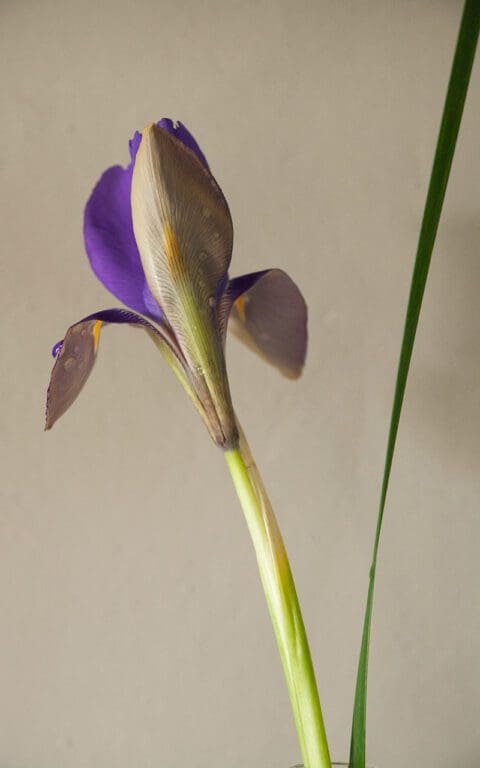
Here, on our hearty loam, I have not been tempted to grow them in anything but full sunshine for fear of our West country wet being their downfall. They are planted in a free-draining position, with plenty of air and paired only with plants that do not smother their growth in summer because their rhizomes need the opportunity to store energy for winter flower. Erigeron karvinskianus and violets make good company. I have also not been tempted to do as the books advise and cut their evergreen leaves in the autumn to reveal the flowers clear of their foliage. Although it is often described as tatty, I like the flowers sitting pure and wild amongst it.
So, here they are on the gravel drive to lighten our daily movements on this well-trodden path. When darkness descends and it is still the afternoon, these small things count.
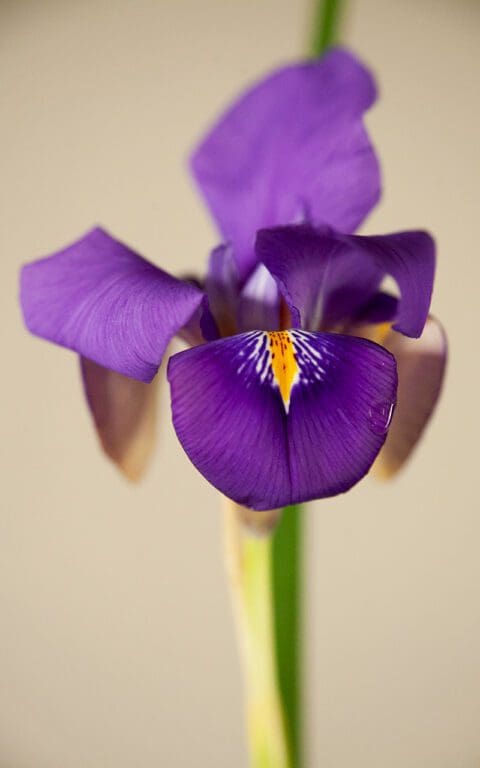
Words: Dan Pearson | Photographs: Huw Morgan
Published 12 December 2020
Huw Morgan | 28 February 2020
When we last saw each other in October Flora and I had planned on her returning to Hillside in the very depths of winter to see what she could create with the skeletons of last year’s growth when there was hardly a flower to be seen in the garden. We pencilled in a late January date in the diary. However, I was taken ill after Christmas and was out of action until early February. This meant that the next available date for us to meet was at the end of last week, when the season was definitely starting to tip into spring.
Flora arrived on Thursday evening with her good friend Paul, who gardens with her at Westhill Farm. He has assisted Flora on the last two shoots here, cutting and conditioning flowers, organising and filling containers and clearing up afterwards, not to mention the laughter and banter. We could not have done any of them without his help. We were all up early on Friday morning, wary of the weather forecast with its warnings of another approaching storm. I had gathered some woody material – hazel, willow and cherry plum – from the hedgerows, woods and garden the previous day, and there was a wide selection of dead material in the tractor barn that I had saved from the garden before Christmas. After breakfast Flora and Paul took a tour of the garden to select the things that took their fancy to bring colour and a feeling of hope to the arrangement.
With storm clouds gathering and wind gusting erratically, and despite the fact that we had decided to make the arrangement under cover, the weather conditions were challenging. On more than one occasion the entire, and nearly completed, arrangement almost blew over. Fortunately Paul was quick off the mark and managed to catch it, preventing it from needing to be entirely remade. Just moments after I had taken the last shot of the finished arrangement a great easterly gust blew into the barn and sent everything flying. We all laughed and understood that the shoot was well and truly over.
Although it was testing working and photographing in these conditions it felt like a very authentic engagement with and recording of the reality of the season.
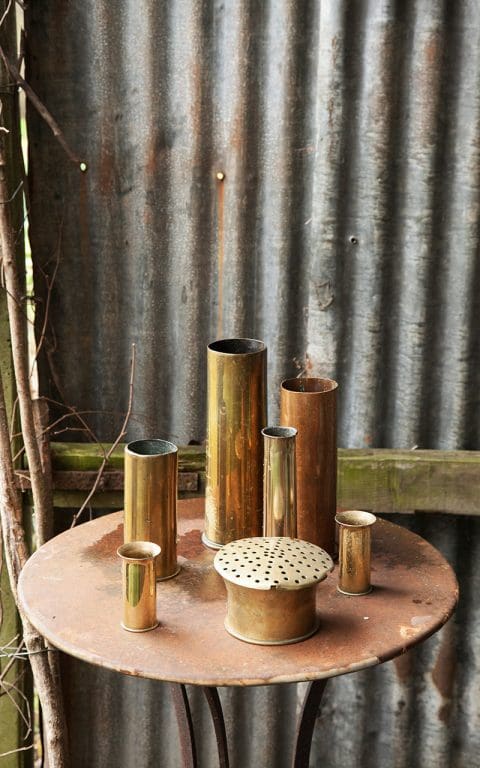
Flora Starkey | 28 February 2020
It is winter at Hillside and there’s a new quieter beauty in the garden. Again, I’m happy to be here on the cusp of the season as spring starts to show beneath the fallen grasses and branches that are bare of leaves.
The rains held off for a few hours on Friday morning, but the winds still blew. Huw and I decided it would be impossible to try and continue our series in front of our usual rusted barn background so we moved behind and into the inside corner of the barn. We both liked the light there and hoped we’d be more sheltered from the elements, but there were still times the wind caught us from the side – all adding to the fun.
I’d used ceramic and glass vessels in the summer and autumn arrangements and so this time I was drawn to the idea of metal. Specifically vases made from old mortar shell casings. I brought a small collection with me, including a bowl with a drilled lid gifted to me by my friend Paul. A remnant of World War 1 and life in the trenches. I like the idea of using flowers to reflect, remember and bring beauty from the darkness. I guess it seemed especially fitting for the season with the violets and primroses showing up and braving the end of winter.
Despite the fact that much of the garden was dormant, Huw cut some beautiful single flowering Prunus from the border hedgerows. These, along with hanging hazel lambs’ tails and a few varieties of silvery, soft catkins formed the base of the shape. I especially loved the snowy delicacy of the Salix purpurea ‘Nancy Saunders’.
Some tall but delicate stems of rosemary and a twist of honeysuckle coming into leaf added some essential green. These were followed pretty quickly by a frame of dried beauties that Huw had saved for me last autumn – some wonderful silver stars of aster and rusty licorice seedheads. It has been interesting for me to recognise how important the dried elements from the season before have felt every time I’ve come here.
With the taller elements in place, I moved to the flowers below the canopy – a single snip from several varieties of hellebore including a double black that I was particularly taken with. With the winds picking up again, it was time to focus on my favourite low lidded vase at the front. This held a tiny carpet of primroses, snowdrops, Cyclamen coum and a violet complete with leaves.
I had wondered how much of a challenge our winter arrangement would be. It might be that it’s my favourite yet.
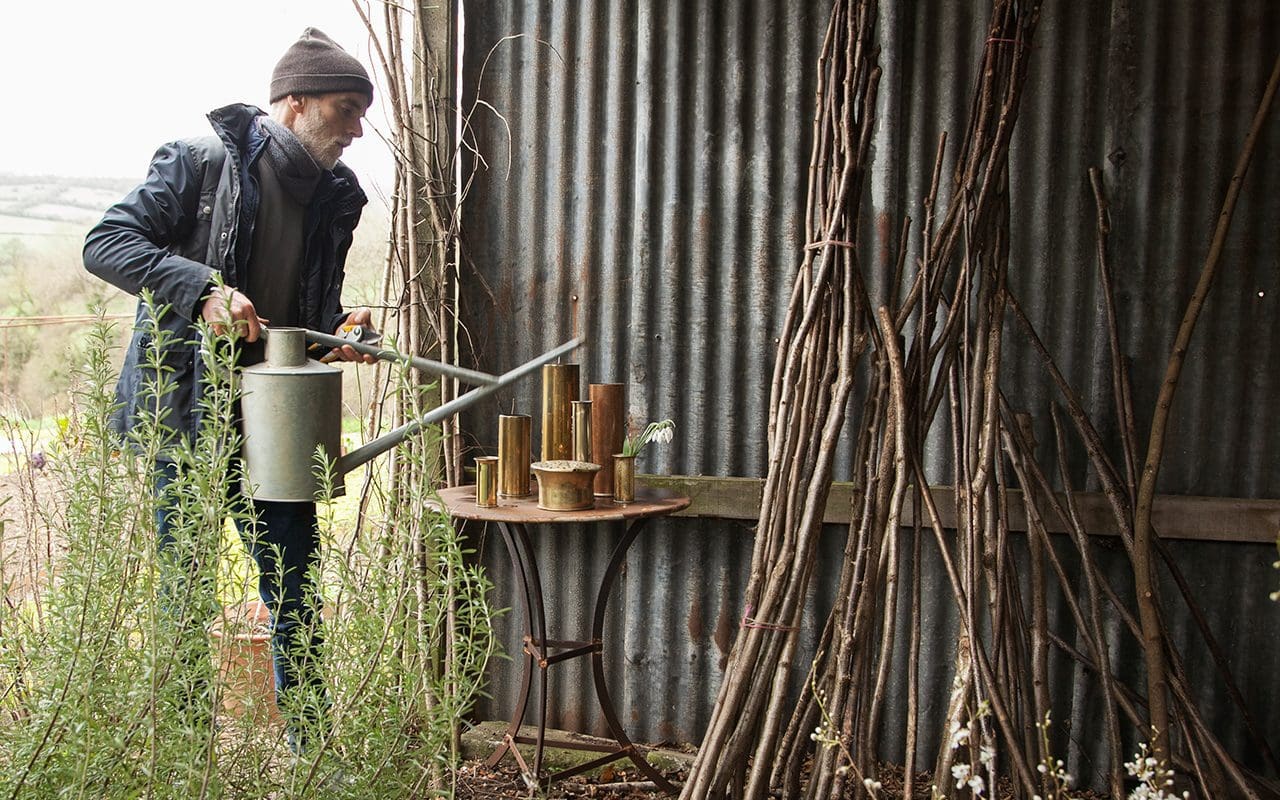
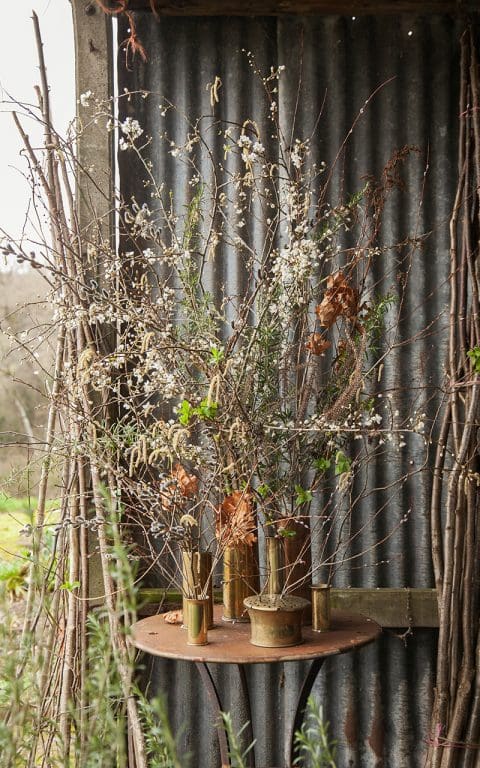
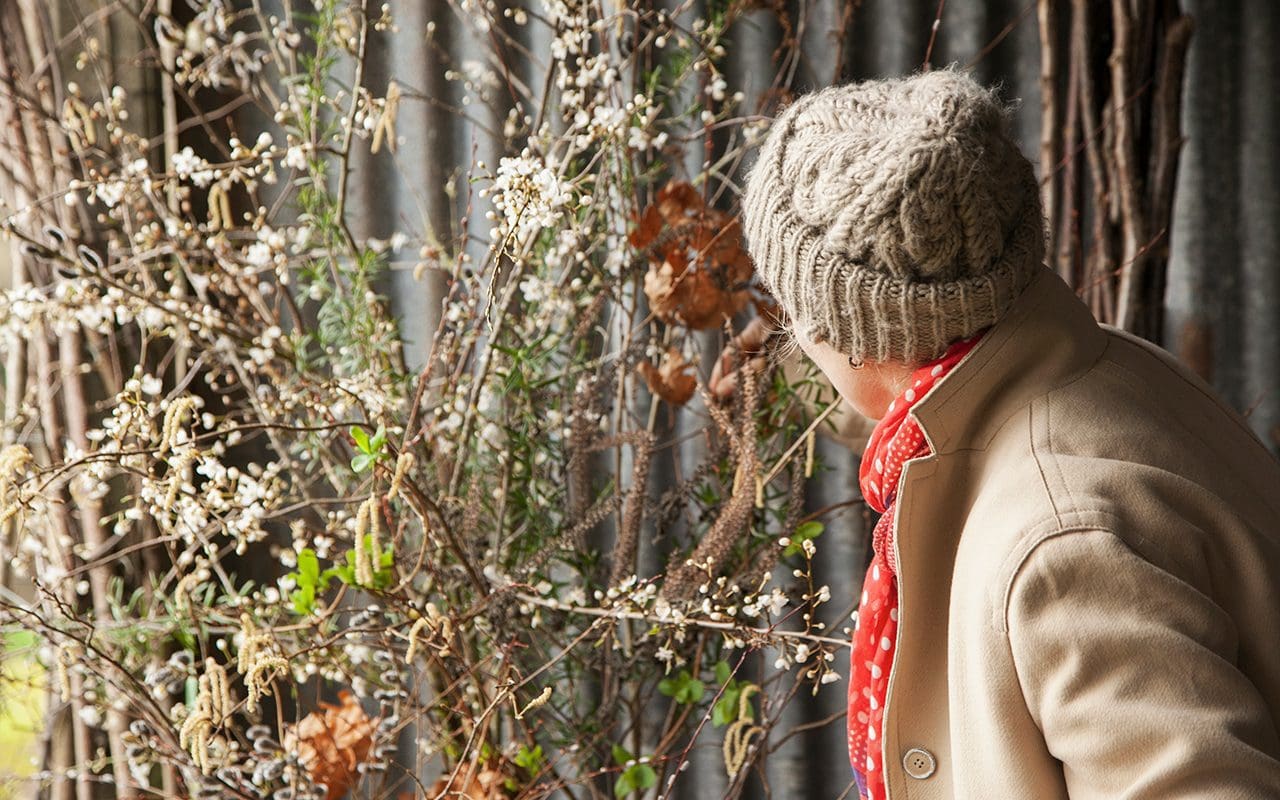

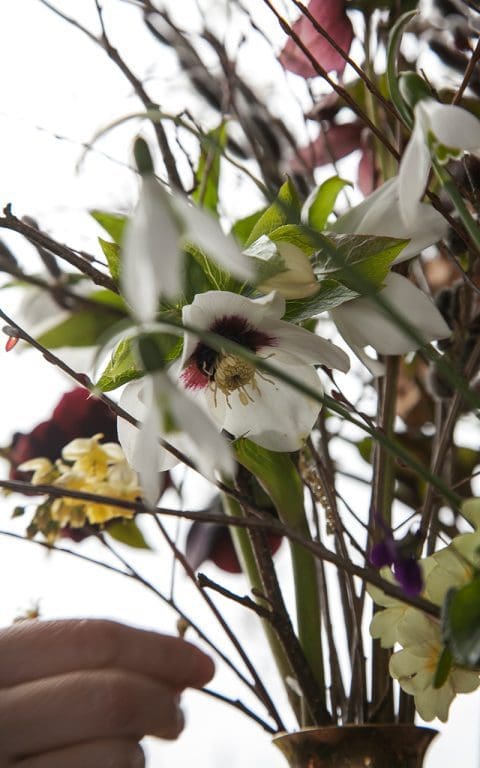
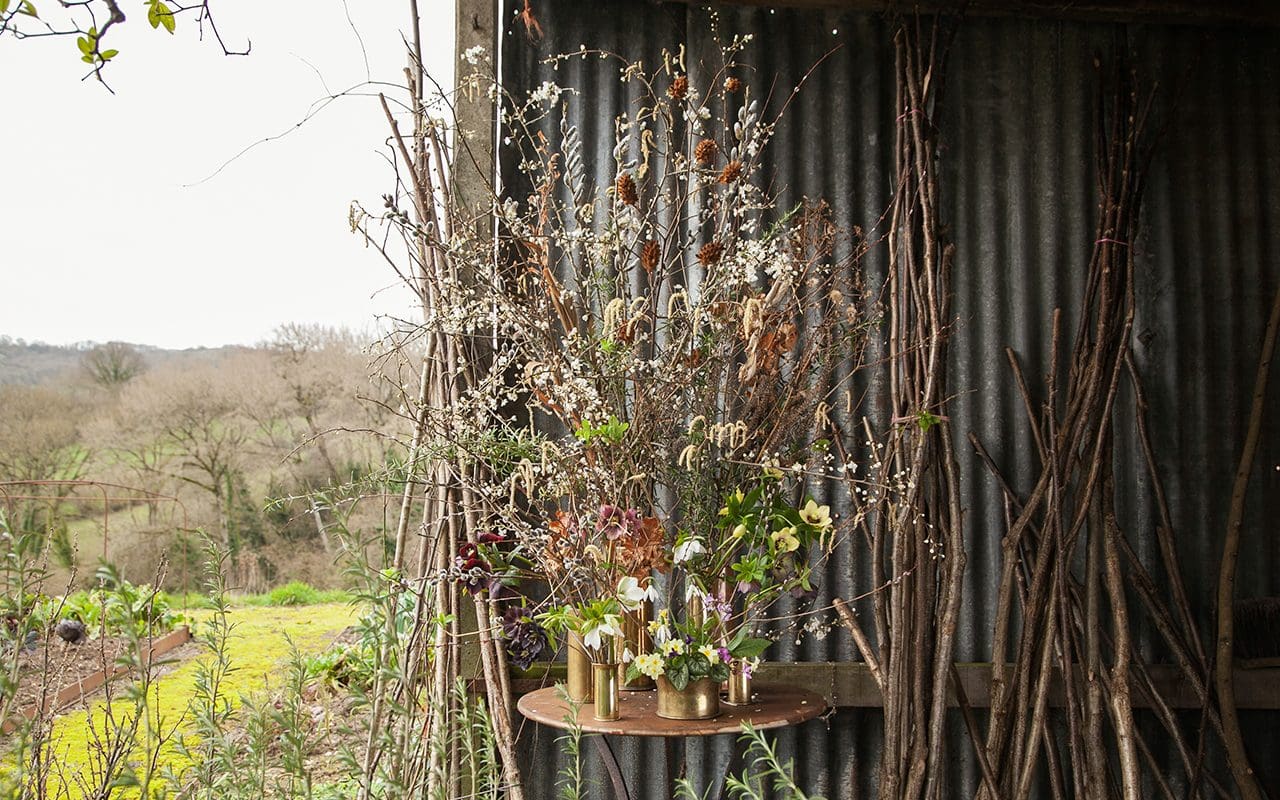
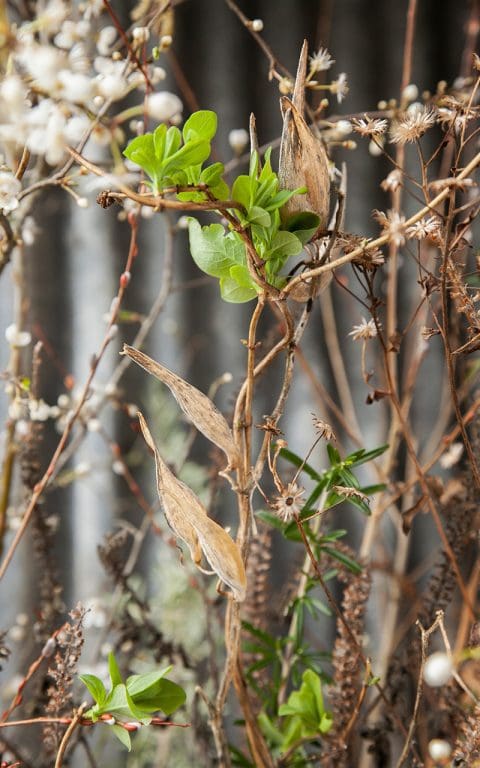
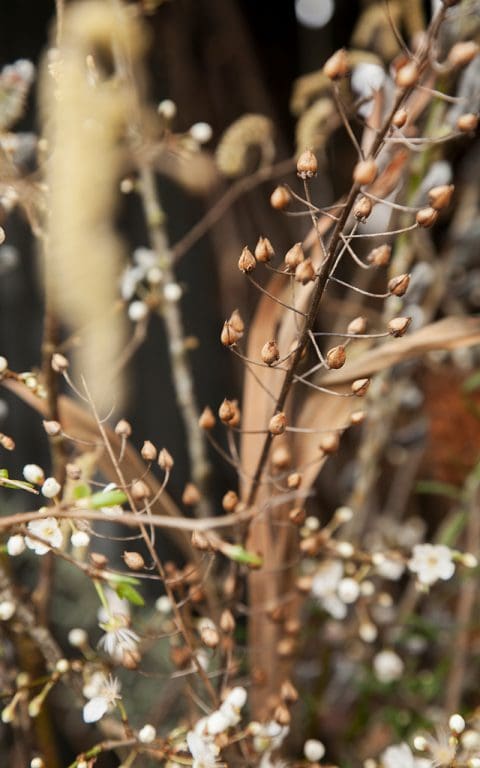
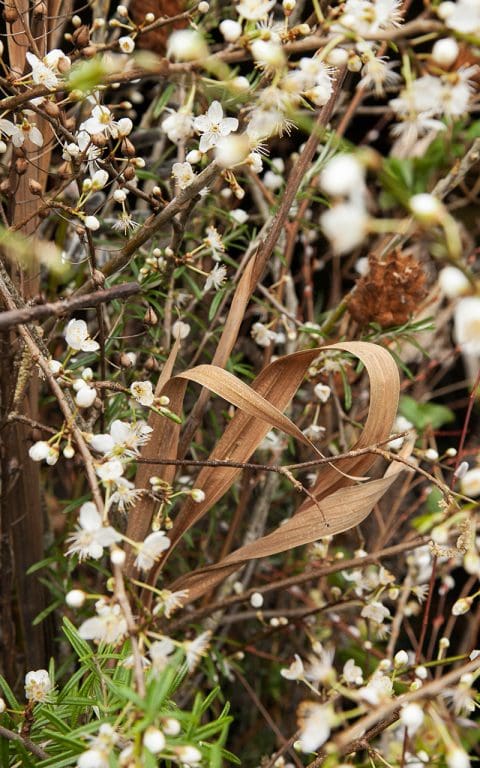
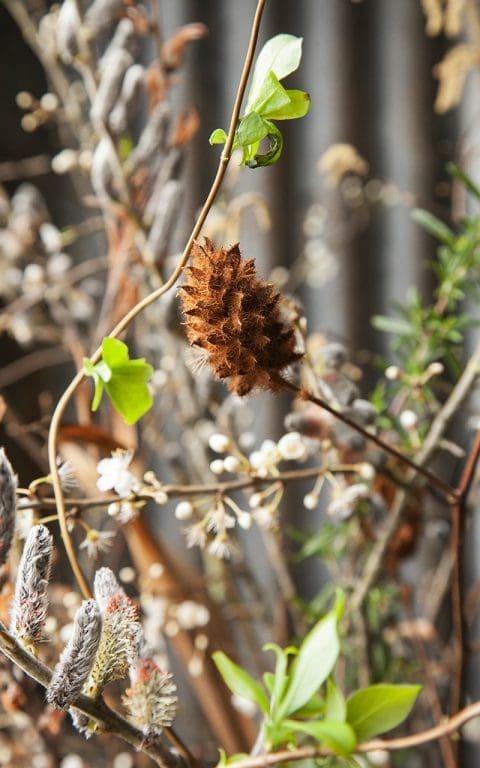
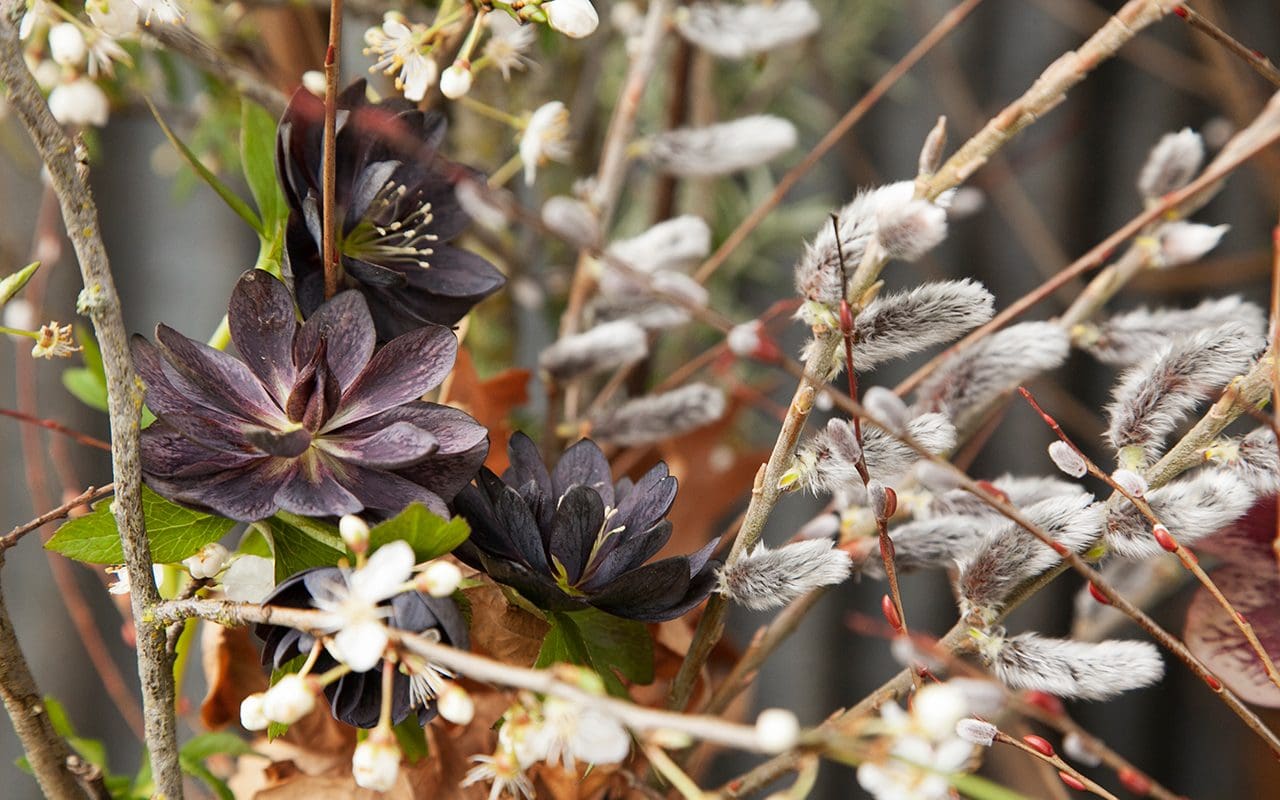
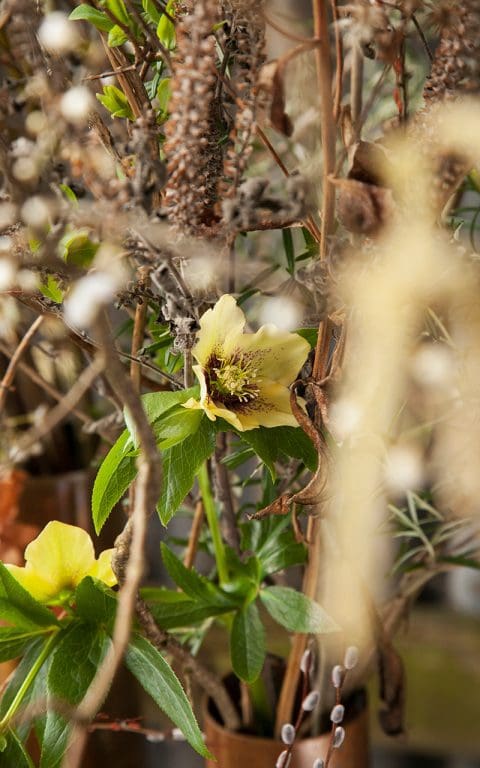
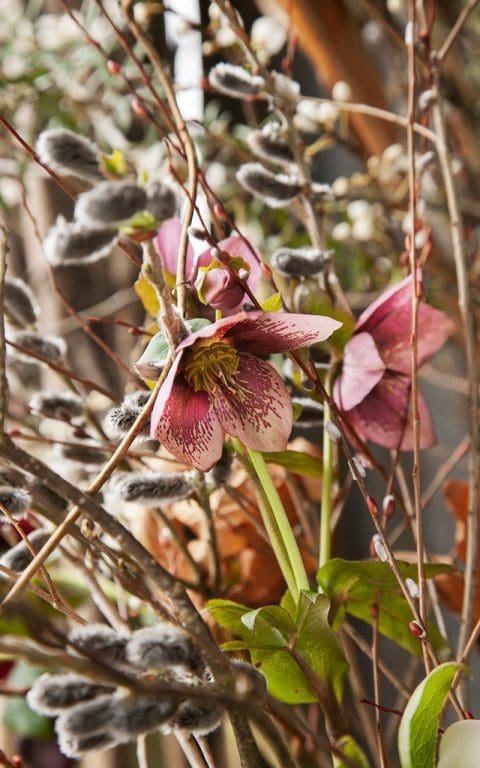
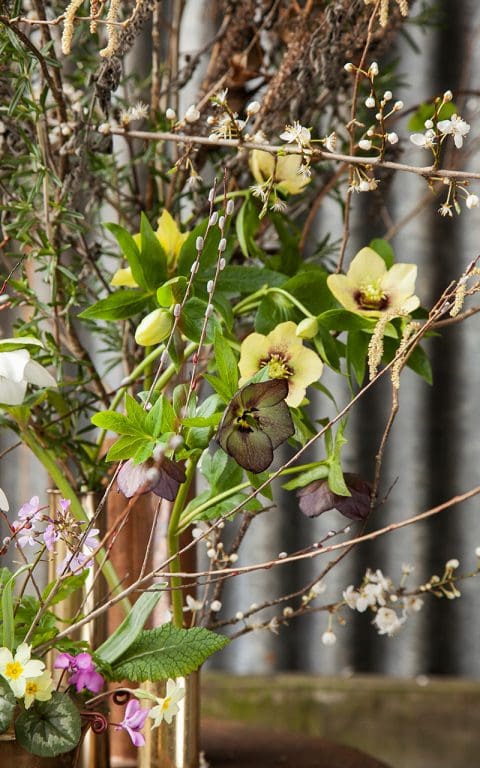
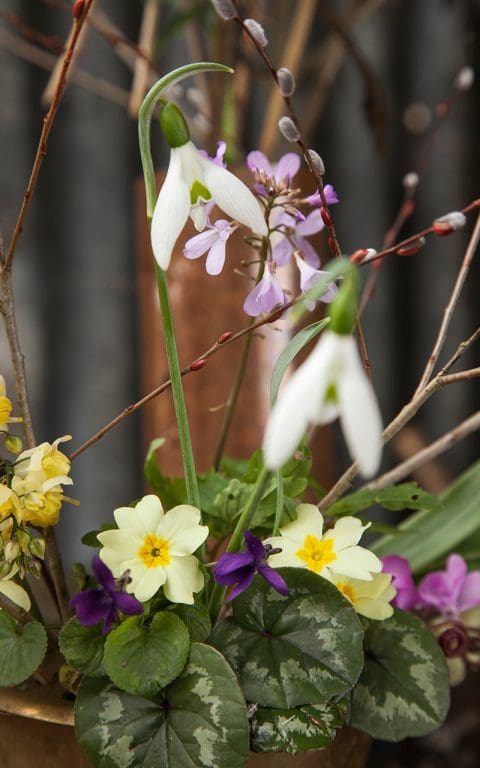
Asclepias tuberosa
Cardamine quinquefolia
Corylus avellana
Cyclamen coum
Epimedium x versicolor ‘Sulphureum’
Eurybia x herveyi
Galanthus elwesii ‘Cedric’s Prolific’
Gladiolus papilio ‘Ruby’
Glycyrrhiza yunnanensis
Helleborus hybridus Double black
Helleborus hybridus Single black
Helleborus hybridus Single Dark Pink Spotted
Helleborus hybridus Single Green Picotee Shades Dark Nectaries
Helleborus hybridus Single white dark nectaries
Helleborus hybridus Single yellow spotted dark nectaries
Lonicera periclymenum ‘Graham Thomas’
Primula vulgaris
Prunus cerasifera
Quercus robur
Rosmarinus officinalis
Salix gracilistyla
Salix purpurea ‘Nancy Saunders’
Teucrium hircanicum ‘Paradise Delight’
Verbascum phoenicium ‘Violetta’
Viola odorata
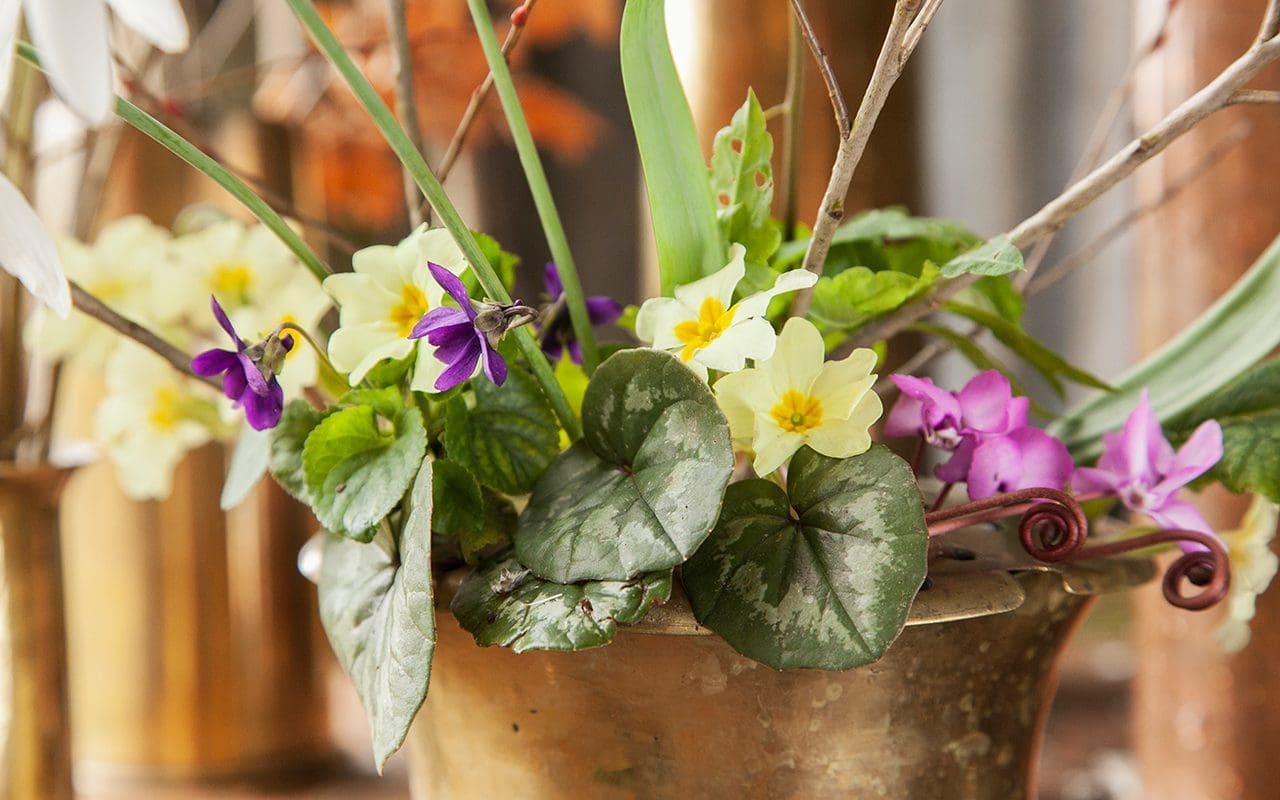
Photographs | Huw Morgan
Published 28 February 2020
We are sorry but the page you are looking for does not exist. You could return to the homepage